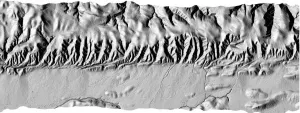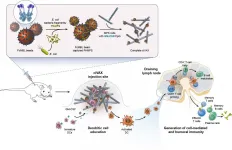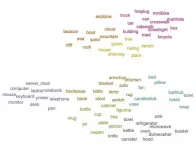LHAASO's measurement of Crab Nebula brightness yields new UHE gamma-ray standard
2021-07-08
(Press-News.org) The Large High Altitude Air Shower Observatory (LHAASO), one of China's key national science and technology infrastructure facilities, has accurately measured the brightness over 3.5 orders of magnitude of the standard candle in high-energy astronomy, thus calibrating a new standard for ultra-high-energy (UHE) gamma-ray sources. The standard candle is the famous Crab Nebula, which evolved from the "guest star" recorded by the imperial astronomers of China's Song Dynasty.
LHAASO has also discovered a photon with an energy of 1.1 PeV (1 PeV = one quadrillion electronvolts), indicating the presence of an extremely powerful electron accelerator--about one-tenth the size of the solar system--located in the core region of the Crab Nebula. The accelerator can energize electrons to a level 20,000 times greater than what CERN's Large Electron-Positron Collider (LEP) can ever achieve, thus approaching the absolute theoretical limit posed by classical electrodynamics and ideal magnetohydrodynamics.
Results will be published in Science on July 8. The LHAASO International Collaboration, which is led by the Institute of High Energy Physics of the Chinese Academy of Sciences, completed this study.
The Crab Nebula is 6,500 light-years from Earth. It was born in a bright supernova explosion in AD 1054. It is the first supernova remnant identified by modern astronomy with a clear historical record. The nebula harbors an energetic pulsar with a period of 30 milliseconds. The fast-rotating magnetosphere of the pulsar drives a powerful wind composed of electron-positron pairs moving at nearly the speed of light. The electrons/positrons in the pulsar wind further accelerate to higher energies once the wind encounters the ambient medium. The nebula is produced by the radiation of the accelerated electrons/positrons.
The Crab Nebula is one of the few sources that has been measured in all energy bands, i.e., radio, infrared, optical, ultraviolet, X-ray and gamma-ray. Its spectrum has been extensively studied for decades by many observers. As a bright and stable high-energy source, the Crab Nebula is regarded as the standard candle for many different energy bands. In this capacity, it serves as a reference for the measurement of other sources.
LHAASO has measured the spectrum of the Crab Nebula at the highest-energy end, covering the broad range 0.0005-1.1 PeV. It has confirmed measurements from the past several decades. It has also achieved an accurate measurement in the UHE band (0.3-1.1 PeV) for the first time, thus calibrating the brightness of the standard candle over such an unprecedented energy range.
Among the 12 UHE gamma-ray sources discovered previously by LHAASO, the Crab Nebula was identified as one of two sources capable of emitting PeV photons, and is the only source with a definite astrophysical counterpart. The measured 1.1 PeV photon provides direct evidence for the acceleration of 2.3 PeV electrons in the source. Such an energy is about 20,000 times the maximum achievable energy of the most powerful man-made electron accelerator, the LEP, which is the predecessor of the LHC. Since high energy electrons suffer strong energy loss in a magnetic field, the accelerator in the Crab Nebula must operate at an incredibly high efficiency to balance the huge energy loss. According to the LHAASO measurement, its acceleration efficiency can reach 15% of the theoretical upper limit, thus surpassing that of the supernova blast wave by a factor of 1,000. This poses challenges to the standard paradigm of electron acceleration in high-energy astrophysics. An in-depth analysis and discussion of this topic are detailed in the current paper in Science.
LHAASO is a major national scientific and technological infrastructure facility focusing on cosmic ray observation and research. It is located at 4,410 meters above sea level on Mt. Haizi in Daocheng County, Sichuan Province and covers an area of about 1.36 km2. It is composed of 5,195 electromagnetic particle detectors and 1,188 Muon detectors located in the square-kilometer complex array, a 78,000 m2 water Cherenkov detector array, and 18 wide-field-of-view Cherenkov telescopes. Using these four techniques, LHAASO will be able to measure air showers generated by cosmic rays or gamma rays omnidirectionally with multiple variables simultaneously.
Basic information about the incident particles, such as arrival direction, type and energy, can be measured through the reconstruction of the showers. The newly published discovery demonstrates that LHAASO is capable of cross-checking measurements using multiple detection techniques, thus insuring reliable and accurate results. LHAASO will be completed this month and put into operation. With an expectation of detecting 1-2 photons with energies around 1 PeV from the Crab Nebula every year, the puzzle of the cosmic PeV electron accelerator will be unraveled in the coming years.
INFORMATION:
[Attachments] See images for this press release:

ELSE PRESS RELEASES FROM THIS DATE:
2021-07-08
As tectonic plates slip past each other, the rivers that cross fault lines change shape. The shifting ground stretches the river channels until the water breaks its course and flows onto new paths.
In a study published July 9 in Science, researchers at UC Santa Cruz created a model that helps predict this process. It provides broad context to how rivers and faults interact to shape the nearby topography.
The group originally planned to use the San Andreas fault in the Carrizo Plain of California to study how fault movement shapes the landscapes near rivers. But after spending hours pouring over aerial imagery and remote topographic data, their understanding of how the terrain evolves began to change. They realized that rivers play a more active ...
2021-07-08
For the first time, Princess Margaret researchers have mapped out where and how leukemia begins and develops in infants with Down syndrome in preclinical models, paving the way to potentially prevent this cancer in the future.
Children with Down syndrome have a 150-fold increased risk of developing myeloid leukemia within the first five years of their life. Yet the mechanism by which the extra copy of chromosome 21 predisposes to leukemia remains unclear.
Down syndrome is a genetic disorder caused by a random error in cell division in early human development that results in an extra copy of chromosome 21. This extra copy is what causes the developmental changes and physical ...
2021-07-08
Proactive, frequent rapid testing of all students for COVID-19 is more effective at preventing large transmission clusters in schools than measures that are only initiated when someone develops symptoms and then tests positive, Simon Fraser University researchers have found. Professors Caroline Colijn and Paul Tupper used a mathematical model to simulate COVID-19's spread in the classroom and published their research results today in the journal PLOS Computational Biology.
The simulations showed that, in a classroom with 25 students, anywhere from zero to 20 students might be infected after exposure, depending on even small adjustments ...
2021-07-08
(BOSTON) -- Current clinical interventions for infectious diseases are facing increasing challenges due to the ever-rising number of drug-resistant microbial infections, epidemic outbreaks of pathogenic bacteria, and the continued possibility of new biothreats that might emerge in the future. Effective vaccines could act as a bulwark to prevent many bacterial infections and some of their most severe consequences, including sepsis. According to the END ...
2021-07-08
Feeling anxious about health, family or money is normal for most people--especially during the COVID-19 pandemic. But for those with anxiety disorders, these everyday worries tend to heighten even when there is little or no reason to be concerned.
Researchers from Indiana University School of Medicine recently studied the behaviors associated with anxiety--published in Psychopharmacology--examining how biological factors impact anxiety disorders, specifically in females. They found that anxiety in females intensifies when there's a specific, life-relevant condition.
The team, led by Thatiane De Oliveira Sergio, PhD, postdoctoral fellow in the laboratory of Woody Hopf, PhD, professor of ...
2021-07-08
Lesbian, gay, and bisexual Veterans from the Vietnam era report PTSD and poorer mental health more often than their heterosexual counterparts, according to an analysis of data from the Vietnam Era Health Retrospective Observational Study (VE-HEROeS).
A greater burden of potentially traumatic events among LGB Veterans, such as childhood physical abuse, adult physical assault, and sexual assault, was associated with the differences.
"This study is the first to document sexual orientation differences in trauma experiences, probable PTSD, and health-related quality of life in LGB Veterans using a nationally representative sample," said Dr. John Blosnich, ...
2021-07-08
ITHACA, N.Y. - Placing rodent traps and bait stations based on rat and mouse behavior could protect the food supply more effectively than the current standard of placing them set distances apart, according to new research from Cornell University.
Rodents cause billions of dollars in losses to the food supply each year, and carry pathogens that can sicken and kill humans, including salmonella, E. coli and Leptospira.
In the 1940s and 50s, scientists recommended that farmers, food manufacturers and distributors evenly space rodent traps or bait boxes in their facilities. But in fact, a new study finds placement based on rat and mouse behavior is more effective.
"From there, it just became a mantra without anybody scientifically evaluating it to see whether this ...
2021-07-08
The new study, titled "Liposomal Extravasation and Accumulation in Tumors as Studied by Fluorescence Microscopy and Imaging Depend on the Fluorescent Label," was published on July 1, 2021, in the prestigious journal of the American Chemical Society, ACS Nano.
Liposomes, a type of nanoparticle, are tiny, fat-soluble vesicles (small, fluid-filled sacs) made from lipids, or fats. They are mainly used to deliver cancer-fighting drugs to tumors, since liposomes are not water soluble and can protect some drugs against breaking down in the body.
Comparing fluorescent labels on liposomes ...
2021-07-08
The recent extreme heat in the Western United States and Canada may seem remarkable now, but events like these are made more likely, and more severe, under climate change. The consequences are likely to be far-reaching, with overwhelmingly negative impacts on land and ocean ecosystems, biodiversity, food production and the built environment.
"The main lever we have to slow global warming is the rate at which CO2 is added to the atmosphere," said Marcus Thomson, a postdoctoral scholar at the National Center for Ecological Analysis & Synthesis at UC Santa Barbara. Thomson is a co-author of a research article just published in Nature ...
2021-07-08
When people see a toothbrush, a car, a tree -- any individual object -- their brain automatically associates it with other things it naturally occurs with, allowing humans to build context for their surroundings and set expectations for the world.
By using machine-learning and brain imaging, researchers measured the extent of the "co-occurrence" phenomenon and identified the brain region involved. The findings appear in Nature Communications.
"When we see a refrigerator, we think we're just looking at a refrigerator, but in our mind, we're also calling up all the other things in a kitchen that we associate with a refrigerator," said corresponding author Mick Bonner, a Johns Hopkins University cognitive scientist. "This is the first time anyone has quantified this and identified ...
LAST 30 PRESS RELEASES:
[Press-News.org] LHAASO's measurement of Crab Nebula brightness yields new UHE gamma-ray standard






